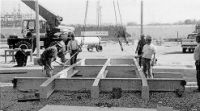 |
ATLSS
Integrated Building System
The Need
The
procedure for erecting building structures has changed very
little during the past few years. Field work requires
workers to perform complicated and strenuous tasks in a
highly dangerous environment. There is a need to develop new
technology to protect workers from the dangerous job
environment and emphasize cost-efficiency, especially in the
construction of multistory structures with repeated cycles. |

ATLSS Connector
|
The Technology
The
AIBS (ATLSS Integrated Building Systems) program was
developed to coordinate ongoing research projects in
automated construction and connection systems. The objective
of this technology is to design, fabricate, erect, and
evaluate cost-effective building systems with a focus on
providing a computer integrated approach to these
activities.
A family of
structural systems, called ATLSS beam-to-column connections,
in both concrete and steel, will possess the capability of
being erected by automated construction techniques. The
technology for automated construction is heavily dependent
on the use of Stewart platform cranes which are controlled
by a system of six cables to allow precise movement in six
directions.
|
 Mortise on column flange and tenon on beam
Mortise on column flange and tenon on beam
|
The Benefits
The
emphasis of these new designs is on cost-efficient
fabrication as well as geometric configurations which
provide an automatic self-guided erection feature to greatly
facilitate initial placement. This feature will minimize
human assistance during construction and will result in
quicker, less expensive erection procedures in which workers
are less susceptible to injury or fatalities.
|

Bay being assembled on ground
|
A
model building frame was developed as a case study to
compare the AIBS system to conventional construction. Based
on the results, the range of projected cost savings with the
introduction of the ATLSS connector was between 9% and 12%.
The range of projected cost saving with both the ATLSS
connector and Stewart platform crane being used was
estimated to be between 12% and 18%. |
Status
ATLSS
researchers demonstrated the connections and a prototype
model of the Stewart platform in February 1992. A consortium
of government, industry, and university partners is
envisioned as the most effective mechanism to move these
technologies from the laboratory to the field. |
Barriers
The
ATLSS connections have been used successfully but the use
has been limited. Future use and technology transfer to the
industry will be required. |
Points of Contact
References
- B. Vincent Viscomi, Le-Wu
Lu, William D. Michalerya, Adam B. Larrabee, & N. Duke Perreira. "Automated
Erection of Structures Utilizing ATLSS Connections and A Robotic
Crane." Microcomputer in Civil Engineering 10 (1995), pp.
309-323.
- B. Vincent Viscomi, Le-Wu
Lu, William D. Michalerya. "Automated construction in the ATLSS
integrated building systems." Automation in Construction 3
(1994), pp. 35-43.
Disclaimer Statement
Neither
the Construction Industry Institute nor Purdue University in
any way endorses this technology or represents that the
information presented can be relied upon without further
investigation. |
|


